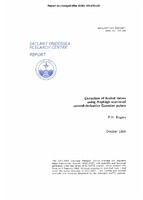| dc.contributor.author | Rogers, P. H. | |
| dc.date.accessioned | 2018-10-11T14:06:53Z | |
| dc.date.available | 2018-10-11T14:06:53Z | |
| dc.date.issued | 1995/10 | |
| dc.identifier | 2013 | |
| dc.identifier.govdoc | SR-235 | |
| dc.identifier.uri | http://hdl.handle.net/20.500.12489/305 | |
| dc.description.abstract | Large ground mines which are intentionally or unintentionally buried in the sediment have proven to | |
| dc.description.abstract | be difficult to detect. This report is the result of a study undertaken by the author while on leave from | |
| dc.description.abstract | Georgia Tech at the NATO SACLANT Undersea Research Centre. It considers the possibility that | |
| dc.description.abstract | low-frequency (200-500 Hz) pulses could be used to detect and localize buried mines. It has been shown that it may be possible to detect buried mines using Rayleigh scattered second derivative Gaussian pulses. The robustness of the method stems from the differences in mechanical properties | |
| dc.description.abstract | of the mine and the wide range of bulk modulus and density of seafloor sediments. | |
| dc.format | 50 p. : ill. ; 20 fig. | |
| dc.language | English | |
| dc.publisher | NATO. SACLANTCEN | |
| dc.relation.ispartofseries | ADB208455 | |
| dc.subject | Mine burial and bottom conditions | |
| dc.subject | Low Frequency Active Sonar (LFAS) | |
| dc.subject | Mine Detection and Clearance | |
| dc.title | Detection of buried mines using Rayleigh-scattered second-derivative Gaussian pulses | |
| dc.type | Scientific Report (SR) | |
